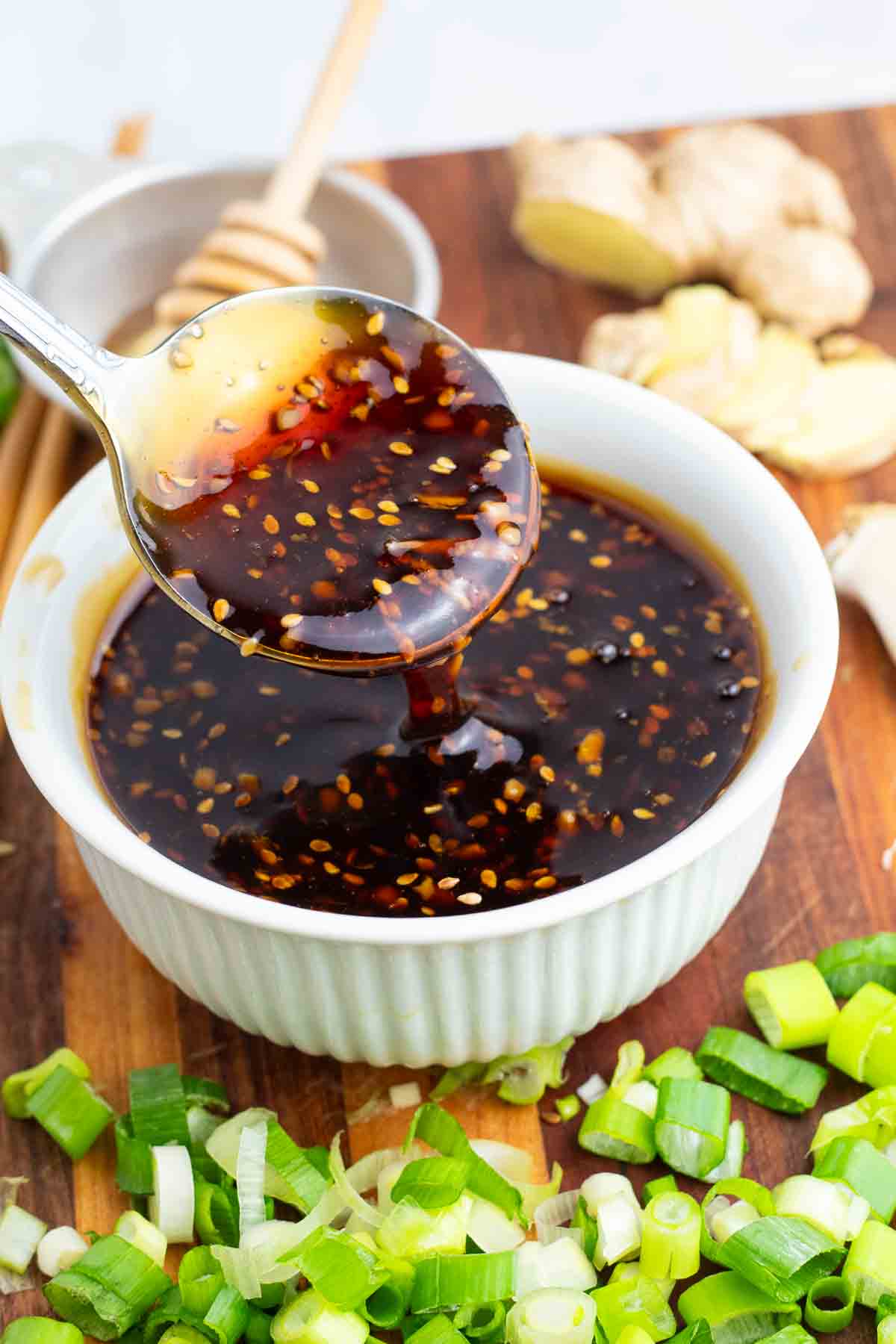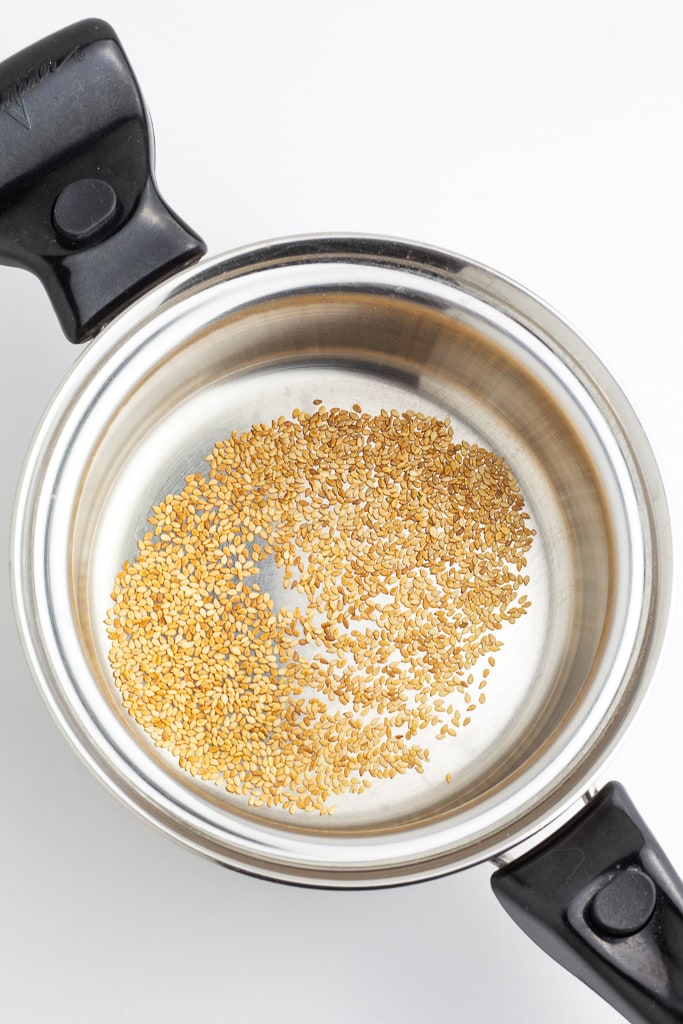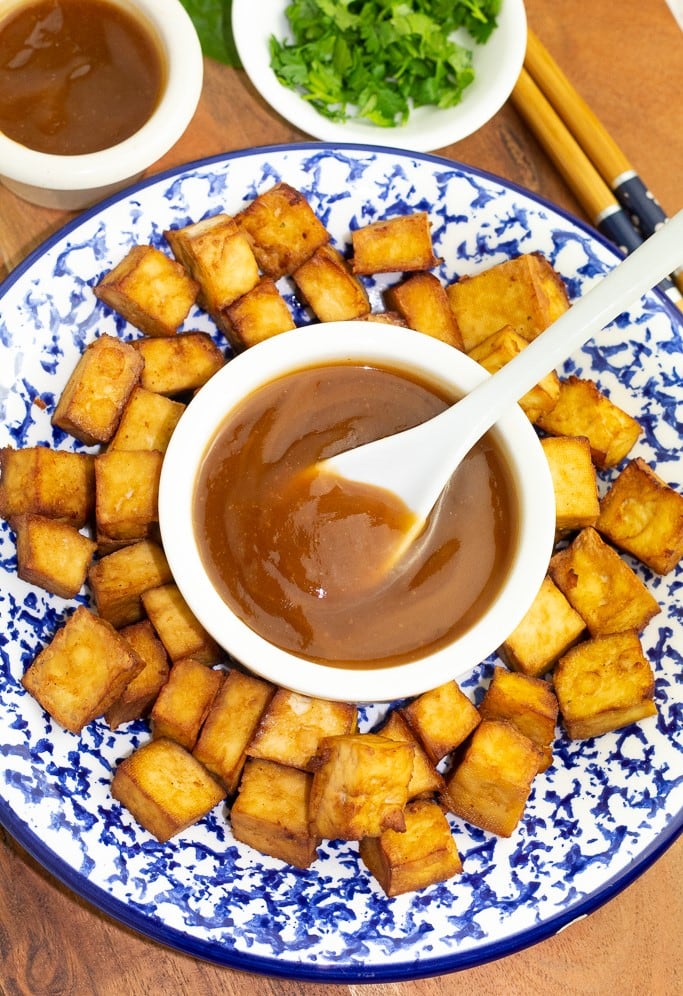Best Teriyaki Sauce (Oil-Free)
Sweet and sticky homemade oil-free Teriyaki Sauce is absolutely delicious when used in stir-fry recipes or even as a marinade. It only requires a few ingredients and can be ready in minutes!

I don’t know about you, but I absolutely love plant-based stir-fries. They are so easy to pull together for dinner, and I’m able to use up any vegetables in my refrigerator that need to go quickly. Our tofu & broccoli teriyaki is a perfect example of a delicious and easy vegan dinner.
Serve them over rice, noodles, or other whole grains like quinoa or bulgur. And, there are so many different oil-free sauce options to choose from, the possibilities are nearly endless! If you love umami flavor, try my easy oil-free miso sauce too because it’s good on everything!
One of my very favorite sauces is this teriyaki sauce that can be made in only about 15 minutes and can be used as a baste, marinade, dipping sauce, or stir-fry sauce.
What is in teriyaki sauce?
Some people think that teriyaki sauce is just another type of soy sauce, but that is not the case. Soy sauce which is very salty is actually used to make teriyaki sauce along with other ingredients which cause it to be a thicker sweeter sauce than just plain soy sauce.
Reasons you will love this sauce
- Rich, Bold Flavor – This oil-free teriyaki sauce offers the perfect balance of sweet and savory, enhancing any dish without added fats.
- Healthier Alternative – Made without oil, it’s a heart-healthy option that still delivers all the deliciousness of traditional teriyaki sauce.
- Vegan & Gluten-Free – Suitable for various dietary needs, this sauce is vegan and can easily be made gluten-free by using tamari or gluten-free soy sauce.
- Versatile & Easy to Make – Whether you’re glazing tofu, stir-frying veggies, or marinating, this simple sauce comes together quickly and adds incredible flavor to any dish.
Ingredients you will need

- Soy sauce– Gives it a salty flavor. To make it gluten-free, tamari can be used as a substitute.
- Honey– Other sweetener options such as bee-free honey, agave nectar, or maple syrup can be used to make vegan.
- Brown sugar– Adds more sweetness but can be left out if desired.
- Rice vinegar– Provides a bit of tangy or sour element to the sauce.
- Ginger– Use freshly grated ginger for a robust flavor, but dry ginger can be substituted.
- Garlic– Minced fresh garlic or from a jar.
- Sesame seeds– Toasted sesame seeds give the sauce a warm nutty flavor.
- Thickener– Either cornstarch or arrowroot powder made into a slurry using water thickens the sauce up nicely for stir-fries. Leave out the thickener to use as a marinade instead.
Pro Tips & Variations
- Marinade- To use this sauce as a marinade, simply skip the thickener and use it in its thinner form.
- Gluten-free- Soy sauce has gluten, so substitute tamari for the soy sauce to make it GF.
- Vegan- Substitutions for the honey can include Bee-Free Honee, agave nectar, or maple syrup.
- Salty- Use low-sodium soy sauce to reduce the sodium content.
- Sweetener- The brown sugar can be left out entirely if desired.
- Ginger- I personally like to use freshly grated ginger, but dry ground ginger can be substituted.
- Garlic- Fresh or minced garlic from a jar gives the best flavor, but ground garlic can be used if desired.
How to make teriyaki sauce
The recipe card at the bottom of the page has the full list of ingredients with measurements and instructions.

STEP #1: Begin by peeling and grating the fresh ginger. Dry ground ginger can be used as a substitution, but I really prefer fresh for a robust flavor.
Oftentimes, I will use the minced type in a jar. If you’re using fresh garlic, go ahead and mince or press it.

STEP #2: In a dry pan, roast approximately 1 tablespoon of sesame seeds until they begin to turn light brown and pop.
Remove them from the heat or they will burn quickly. Pour them into a cup or bowl and set them to the side.

STEP #3: Next, place all the sauce ingredients–soy sauce, water, honey, brown sugar, rice vinegar, ginger, garlic, and toasted sesame seeds–in the saucepan. EXCEPT, don’t add the thickener yet (cornstarch or arrowroot powder).
Heat to medium and whisk together well until it begins to simmer nicely.

STEP #4: In a small bowl, whisk together 1 heaping tablespoon of arrowroot powder or cornstarch, plus 2 tablespoons of water to create a slurry thickener.
Add it to the saucepan with other ingredients and whisk as it begins to thicken.

STEP #5: Once it thickens to the desired consistency, remove it from the heat to stop the thickening process. Serve in stir-fries like this Tofu Teriyaki with Broccoli. Or, use it as a dipping sauce or for basting.
Frequently Asked Questions
To thicken it, use cornstarch or arrowroot powder. Mix 1-2 teaspoons with water to make a slurry, then whisk it into the simmering sauce until it thickens.
It can be! Simply use tamari or a certified gluten-free soy sauce in place of regular soy sauce to make the teriyaki sauce gluten-free.
Yes, it works well as a marinade for tofu, vegetables, and plant-based proteins. The savory-sweet flavors infuse well without the need for oil.
This sauce can be stored in an airtight container in the refrigerator for up to a week. Make sure to stir it well before use, as it may thicken or separate slightly over time.

More Oil-Free Asian Stir-Fry Sauces
For those of you new to the whole food plant-based lifestyle, we’ve created a FREE 7-Day Plant-Based Menu Planner to help you get started!
If you try this recipe, please let us know how you like it by rating it and leaving a comment. We love to hear from you!
Want to Save This Recipe?
Enter your email & I’ll send it to your inbox. Plus, get great new recipes from me every week!
By submitting this form, you consent to receive emails from EatPlant-Based

Best Teriyaki Sauce
Ingredients
- 1 tablespoon sesame seeds
- 1/2 cup low sodium soy sauce tamari for gluten-free
- 1/4 cup water
- 1/4 cup honey bee-free honey or agave nectar
- 2 tablespoons brown sugar or maple syrup
- 2 tablespoons seasoned rice vinegar
- 1.5 teaspoons grated ginger
- 1 teaspoon garlic minced
- 1 tablespoon arrowroot powder or cornstarch PLUS 2 tablespoons water
Instructions
- Begin by peeling and grating the fresh ginger. Dry ground ginger can be used as a substitution, but I really prefer fresh for a robust flavor.
- Oftentimes, for the garlic, I will use the minced type in a jar. If you’re using fresh garlic, go ahead and mince or press it.
- In a dry pan, roast approximately 1 tablespoon of sesame seeds until they begin to turn light brown and pop. Remove from the heat or they will burn quickly. Pour them into a cup or bowl and set to the side.
- Next, place all the sauce ingredients–soy sauce, water, honey, brown sugar, rice vinegar, ginger, garlic, and toasted sesame seeds–in the saucepan. EXCEPT, don’t add the thickener yet (cornstarch or arrowroot powder). Heat to medium and whisk together well until it begins to simmer nicely.
- In a small bowl, whisk together 1 heaping tablespoon of arrowroot powder or cornstarch, plus 2 tablespoons water to create a slurry thickener. Add it to the saucepan with other ingredients and whisk as it begins to thicken.
- Once it thickens to the desired consistency, remove it from the heat to stop the thickening process. Serve in stir-fries like this Tofu Teriyaki with Broccoli. Or use as a dipping sauce or for basting.
Video
Notes
- Marinade- To use this sauce as a marinade, simply skip the thickener and use it in its thinner form.
- Gluten-free- Soy sauce has gluten, so substitute tamari for the soy sauce to make it GF.
- Vegan- Substitutions for the honey can include Bee-Free Honee, agave nectar, or maple syrup.
- Salty- Use low-sodium soy sauce to reduce the sodium content.
- Sweetener- The brown sugar can be left out completely if desired.
- Ginger- I personally like to use freshly grated ginger, but dry ground ginger can be substituted.
- Garlic- Fresh or from a jar gives the best flavor, but ground garlic can be used if desired.
Nutrition
Disclaimer
To obtain the most accurate representation of the nutritional information in a given recipe, you should calculate the nutritional information with the actual ingredients used in your recipe, using your preferred nutrition calculator. You are solely responsible for ensuring that any nutritional information provided is accurate, complete, and useful.
About Terri Edwards
Hi guys! I am the content creator behind EatPlant-Based and a licensed Food for Life instructor with the Physicians Committee for Responsible Medicine. I am passionate about sharing healthy recipes and tips to empower others to get healthy. I’m so glad you’re here! Read More…






if I made enough of this to keep in a jar in the fridge, how long would it be good for? used for dipping
Hi Audrey- It should be good for 7-10 days in an airtight container in the refrigerator.